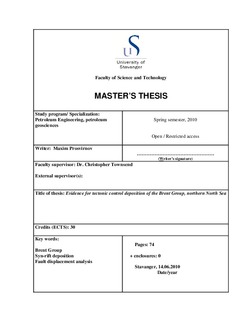| dc.contributor.author | Prosvirnov, Maxim | |
| dc.date.accessioned | 2010-10-22T14:21:13Z | |
| dc.date.available | 2010-10-22T14:21:13Z | |
| dc.date.issued | 2010 | |
| dc.identifier.uri | http://hdl.handle.net/11250/183291 | |
| dc.description | Master's thesis in Petroleum engineering | en_US |
| dc.description.abstract | Detailed examination of well-constrained three-dimensional seismic data introduces the role of tectonics in controlling the nature of syn-rift sequences on the hanging wall of faulted blocks, typical Late Jurassic structural traps in Northern North Sea at all and Gullfaks field in particular. Facies architecture, thickness variations and the internal character of the Brent Group allows to evaluate the syn-rift nature of deposition with strong influence of sub-basin geometry. Significant variations in displacement (throw) along the fault length exhibit characteristics of interplay between tectonics, sedimentation and relative sea level change. Fault displacement analysis combined with detailed study of isopach and dip maps for each of the key formations of the Brent Group show the results with far-reaching consequences for existence additional stratigraphic traps attractive for development drilling. | en_US |
| dc.language.iso | eng | en_US |
| dc.publisher | University of Stavanger, Norway | en_US |
| dc.relation.ispartofseries | Masteroppgave/UIS-TN-IPT/2010; | |
| dc.subject | petroleumsteknologi | en_US |
| dc.subject | petroleumsgeologi | en_US |
| dc.subject | Brent Group | en_US |
| dc.subject | Syn-rift deposition | en_US |
| dc.subject | fault displacement analysis pages | en_US |
| dc.title | Evidence for tectonic control deposition of the Brent Group, northern North Sea | en_US |
| dc.type | Master thesis | en_US |
| dc.subject.nsi | VDP::Technology: 500::Rock and petroleum disciplines: 510 | en_US |
| dc.source.pagenumber | 74 p. | en_US |
